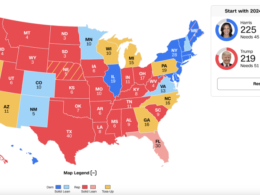Hey, Siri! Help book me a trip somewhere warm in the final week of January.
If the latest Farmers’ Almanac prediction is true, you might want to put your toes in the sand after Christmas. The coming winter will be wet and cold in most places, according to the almanac’s outlook.
The Farmers’ Almanac has been making long-range weather forecasts for more than 200 years.
According to its latest outlook, released Tuesday, you should prepare yourself for the “Wet, Winter, Whirlwind” ahead. Its annual extended weather prediction calls for a season of rapid-fire storms that will bring both rain and snow.
The listing shows a very active storm track that will deliver frequent bouts of heavy precipitation and strong, gusty winds over most of the eastern half of the country. However, the outlook notes that the effects of La Niña will make a difference in how the weather will be.
If you’re new to the term La Niña, it describes the periodic cooling of ocean surface temperatures in the central and eastern equatorial Pacific. According to NOAA, La Niña is arriving a bit later than expected, with forecasts indicating an emergence during the winter.
If you are a planner, go ahead and block out January 20-27, in particular, for that tropical getaway. That’s when the Farmers’ Almanac outlook likely showed “copious amounts of snow, rain, sleet and ice,” depending on where you live.
Readers in Texas and the Northwest: Circle the beginning of February for a possible snowstorm. The Farmers’ Alamanac predicts up to 6 inches in the Lone Star State and a foot of snow likely to be dumped in the Bitterroot Mountain range of Idaho.
For all those chionophiles who thrive in bitter winter conditions, the season’s coldest temperatures will be found from the northern Plains to the Great Lakes region, according to the Farmers’ Almanac. Between the end of January and the beginning of February could be the coldest days, especially farther to the north.
If you think you might be out of the woods, think again. The long-range weather outlook shows that frigid Arctic air is bringing a sharp plunge in temperatures almost nationwide.
If that doesn’t tempt you to dust off those suitcases in the basement yet, the Farmers’ Almanac said that as the frosty air blows across the Great Lakes, heavy snow showers and snow squalls will bring intense bursts of snow to the east.
Have you had enough of the wet winter whirlwind yet? Well, bundle up, New Englanders.
According to the Farmers’ Almanac outlook, the Northeast will be stormy with above-normal amounts of winter precipitation and near-to-above-normal temperatures. It also predicts the heaviest snowfall will occur over the interior and mountainous areas, while the coast will see sleet and rain — especially near and along the Interstate 95 corridor.
If the warm tropics are not feasible after that extensive Christmas shopping list for the in-laws, you might consider a road trip to Texas, western Kansas, Oklahoma, portions of Nebraska and New Mexico, or up across the Southeast and Atlantic Coast.
That’s where you are likely to experience a warmish winter, with above-average temperatures, according to the Farmers’ Almanac. The Southwest will see average winter temperatures, while the Pacific Northwest will be unseasonably chilly.
The Farmers’ Almanac noted that the eastern third of the country will experience above-average precipitation, especially in the Great Lakes, Ohio Valley and Midwest. The Pacific Northwest will also experience a wet winter. However, the Southwest and south-central states are on track for a winter with average to below-average precipitation.
The big question: Whom to invite to indulge in those piña coladas on the beach?
Hey, Siri! Call Mom.









